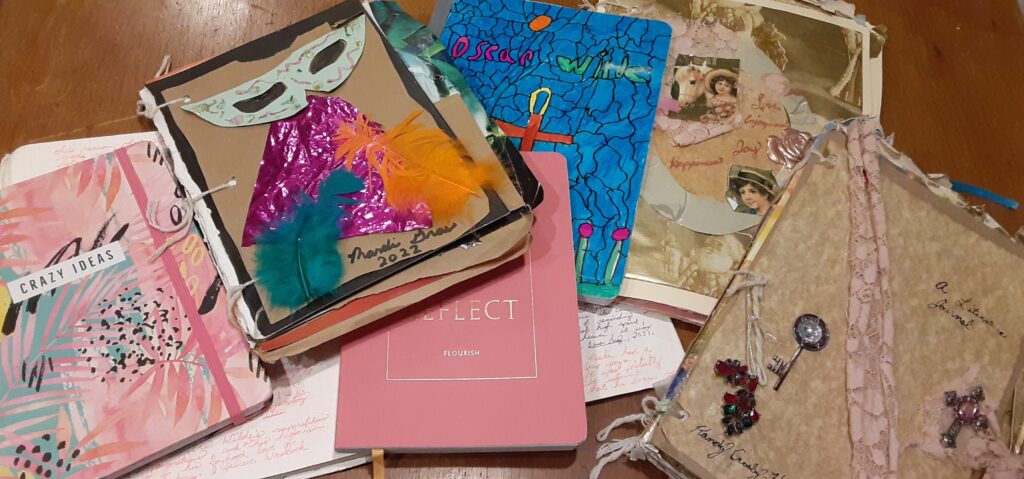
A New Journey
A few years ago, when my sons were younger, I decided to begin keeping scrapbooks about trips to our favorite locations around Kansas. We have always enjoyed exploring the state for fun places that may be overlooked in popular attractions books. To the chagrin of one of my sons, I had to take tons of photos of our excursions (and of both of them on these expeditions. I admit, I still do this, even though one son has now graduated from high school and the other will this year). I needed something to do with my motherly treasures. Scrapbooking sounded like a great idea.
Upon my well-thought out plan, I purchased scrapbooking albums, paper, and glittery stickers and began my scrapbooking journey. I filled one book. Yay me! I began another. The inevitable then happened. I ran out of printer ink to print my photos and realized scrapbooking could be a bit pricey for our family budget. I became discouraged and, I admit, I gave up. (Cue sorrowful groans). Oh, well. C’est la vie.
Scrapbooking
Even though scrapbooking was not my preferred method of documentation and creativity, I encourage you to give it a try. Scrapbooks allow us to organize our memories by theme. Just pick what theme you want for your first scrapbook, gather the important keepsakes you want to include in that scrapbook and start your journey. Scrapbooks are often made from binders or albums and acid-free paper or card stock. As you paste your important memorabilia into your collection, add notes to record memories about your special photos. Some like to embellish scrapbook pages with drawings or favorite bric-a-brac. Scrapbooks can become your own, precious work of art. Hmm. Maybe I should give scrapbooking another try. Come to think of it, at the Salina Public Library, for just ten cents a page, I can make black and white copies of the photos I have taken!
Journaling
Fast forward a few years from my scrapbooking attempts. I had purchased a biography of one of my favorite classic authors, Nathaniel Hawthorne, from a Friends of the Library book sale. This book discussed how this author’s wife faithfully journaled, even if it was just a sentence or two some days. This made me think. I pondered the idea, in a hundred or two hundred years, what will people have to remember us? Those of us who live in the twenty-first century have journals and letters from times past – what we historians call primary sources. It seems the only thing people would have to remember me by would be some Facebook posts or emails. Therefore, I determined to begin keeping a journal of my own.
I am happy to report I have done much better at journaling than I did with scrapbooking. In fact, I have several journals. I adore writing about my personal studies and research, of interesting ideas or things I have learned. (You should see the journals I have about my studies of Oscar Wilde, another of my personal favorite authors and historical fascinations). I keep a journal of books I have read. I give each book a star rating and proclaim in writing all its glories and downfalls. I keep a journal of my deepest, darkest feelings. (No one else gets to see it). In yet another journal, I write about my sons’ educational endeavors, accomplishments, and interests. I record in another journal things I have accomplished – even the tiniest things – each day. Traditional journals are kind of like scrapbooks, only the records are written rather than being kept through visual means.
I spice up my journals by writing in different colors of ink. I stock up on multi-colored pens at back-to-school sales. This allows me to color-code my research journaling and match colors to my moods, too. When I have the time, I even use a quill and ink to write in my journals.
Bullet Journaling
Many people keep a bullet journal. Bullet journals are called bullet journals because they include creatively-designed bullet points rather than lengthy sentences. Bullet journals can be used to record daily to-do lists, meal plans, or remembrances of how the day went. You can even use it as a record of counted steps or to document how much sleep you have been getting. Some bullet journalers write about goals and use their journals as a way to contemplate ideas and feelings and decompress for self-care.
Those who bullet journal often use a notebook with a grid or dots. They plan their journal’s theme and then make headings to coincide with each theme. The key to bullet journaling is for the journaler to begin with an index. The index helps bullet journalers keep track of the upcoming pages. The rest of the journal is comprised of room for goals, spaces for thoughts, or whatever other information the journaler has included in the index. It’s also enjoyable to decorate a bullet journal with dandy doodles, fancy fonts, personal paintings, and other added artsy arrays.
Junk Journaling
A couple years ago, I was browsing the internet and came across a photo that intrigued me. This photo pictured a beautiful journal containing different types of paper and lace and ephemera from past decades. The creator of this shabby chic, artistic conglomeration described it as a junk journal. I began scouring the internet for articles and videos to tell me just what a junk journal is and how to make one. I discovered junk journals are just what they sound like. They are journals made from the junk – the extra stuff – we often have lying around the house. Covers can be made from anything sturdy – covers of old books that are falling apart, notebook covers, even cardboard or cereal boxes. The pages can be any type of paper one has handy.
Of course, I began searching my house for materials. I saw the key to making beautiful and unique junk journals is making them look different than traditional notebooks or journals. For instance, instead of placing all pieces of notebook paper with the lines running horizontally, I should stick a few in with the lines running vertically. Instead of neatly and evenly cutting all the pages, I should tear some of them for a ripped, worn look. I could add pieces from old calendars or magazines, even newspapers. I could paste stickers or sequins to add pizzazz.
In one of my favorite junk journals, I covered the front and back of a disassembled spiral notebook with wrapping paper, parchment, and scraps of lace. I tied the covers together with rough twine instead of using the metal spiral. I then used this same twine to secure a broken earring with pretty red and blue stones to the front cover. I added construction paper, parchment, and ripped paper sacks as some of the inside pages. The result was a beautiful journal that has become my literary journal – that one I use to keep track of the books I read. Junk journals combined my want for scrapbooking and my love of journaling. As a bonus, I did not have to worry about making it look perfect. It’s not supposed to look flawless. (That’s a good thing because I am the least crafty person I know).
Digital Journaling and Scrapbooking
If you are a tech lover, you might be interested in digital journals or digital scrapbooks. Digital scrapbookers use special software to create their masterpieces. They scan and crop photos and design everything on the computer. Many then print the scrapbook pages on their own or have them professionally printed and bound. If you prefer to work with technology rather than glue and craft supplies, digital scrapbooking may be for you.
Those who prefer to use a digital journal download special apps on which to record their activities and thoughts. Some digital journals are similar to daily diaries. Other apps provide prompts for writers to process and write about their thoughts. Some people choose to use digital journals to record their work activities and experiences. Digital journals may be good for individuals who are more pressed for time but want to spend at least a few minutes a day recording activities and thoughts.
We’re Here to Help
If you would like to find out more about journaling, scrapbooking, or junk journaling, Creativebug has a lot of fantastic information. Creativebug can be found under the services tab on the Salina Public Library website. On-site, we also have several books that contain scrapbooking ideas. We even have books about how to start your own scrapbooking business and some nice scrapbooking-themed mysteries you may want to relax with after all your hard work. You can also find books that may help you on your journaling journey. If you feel stuck about how to begin writing a journal, you may find our book of fifty-two possible journaling topics helpful.
Ready to Give It a Try
Whatever your chosen method, creating a keepsake of events, thoughts, and feelings is a great way to destress and share important ideas. Journaling and scrapbooking allow us to indulge in our creativity, whether that individuality is best expressed through crafty projects, writing, technology, or a combination of all the above. I encourage you to give these hobbies a try. I’m glad I did. Now where did I put that empty scrapbook album?

About The Author: Kandy
Kandy works as a circulation clerk at the Salina Public Library. She is a life-long Salina resident. She holds bachelor’s degrees in religion and education and master’s degrees in human services counseling with a cognate in Christian ministries, history, and professional writing from Liberty University. Aside from working at the library, she also teaches online classes in writing, history, and classic literature. She is married with two sons, who have always been homeschooled. Her hobbies include reading, visiting historical sites and museums, collecting historical items, and, of course, writing every chance she gets.
More posts by Kandy